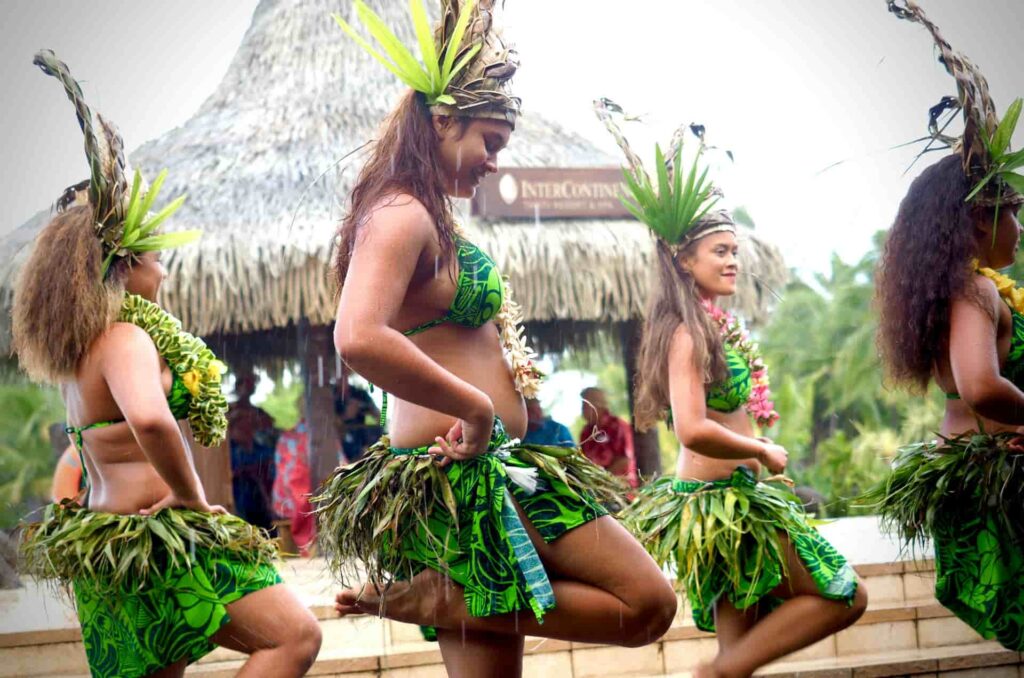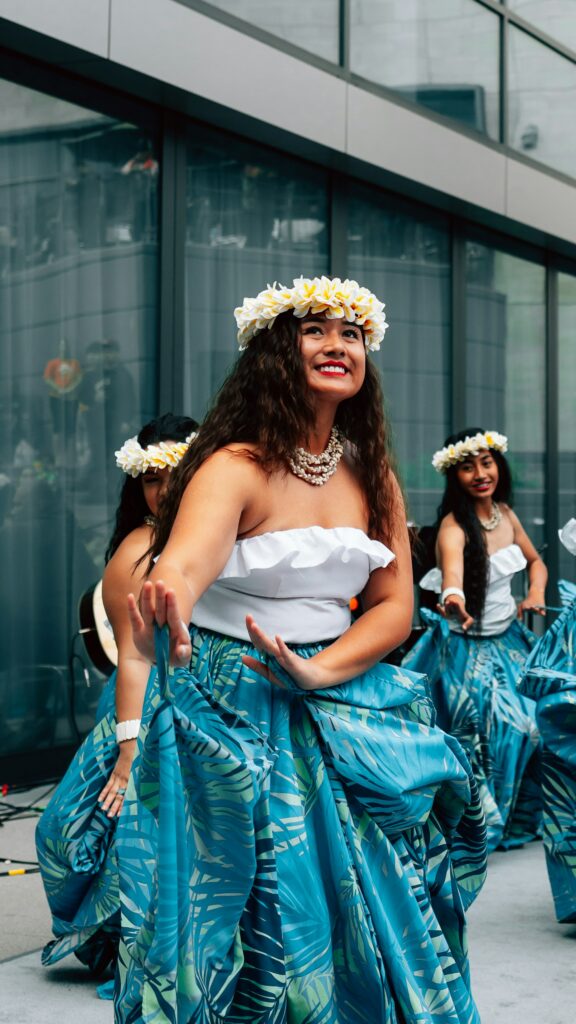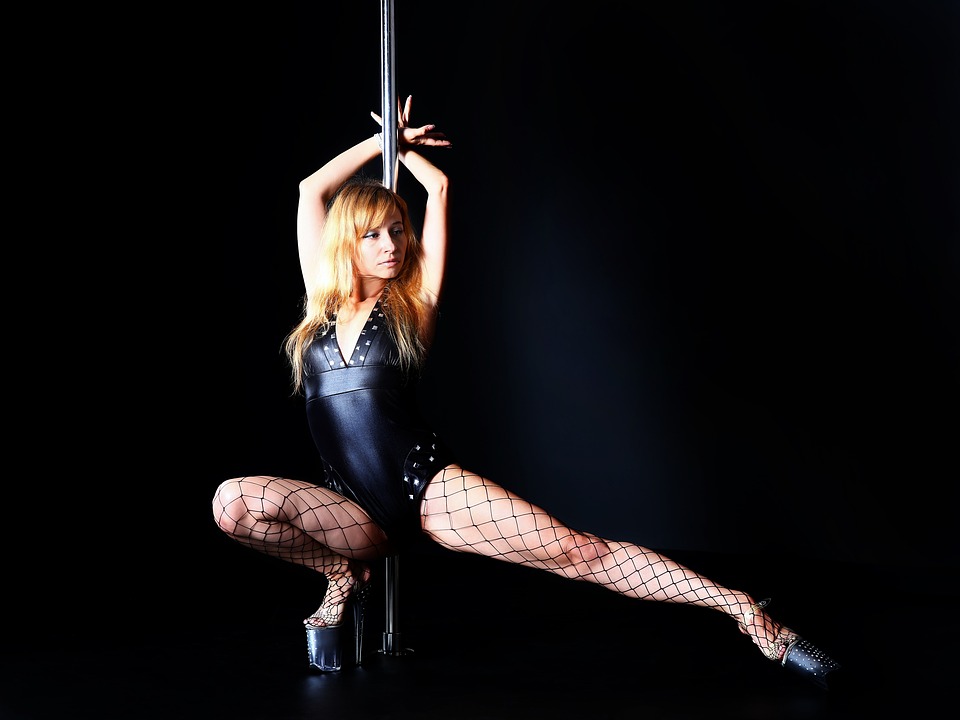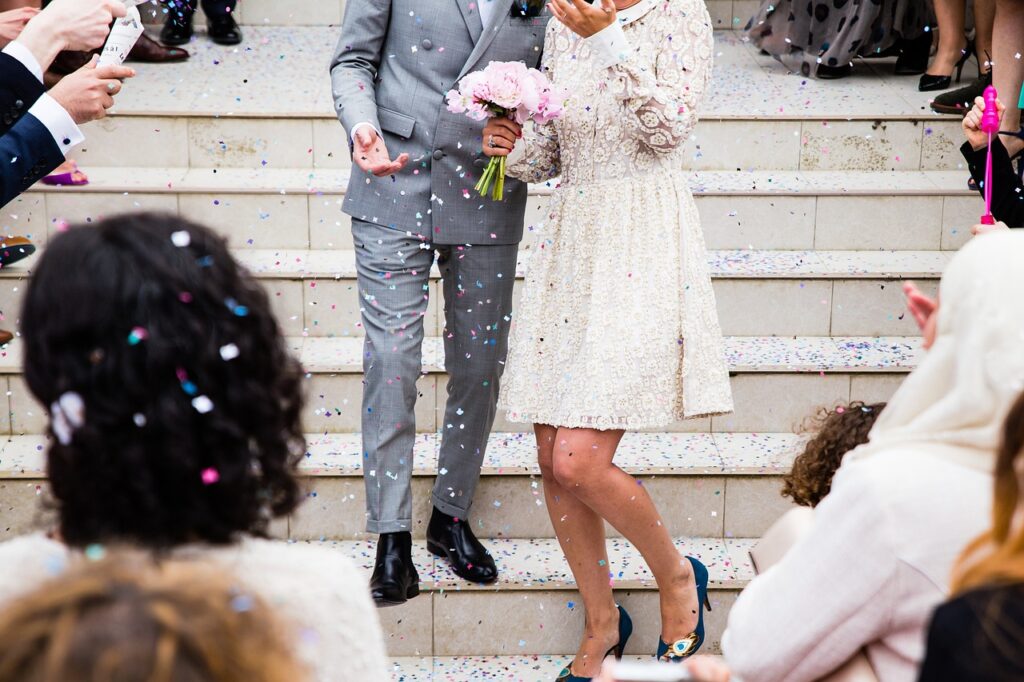
Summary
Tahiti dances: Pacific dances to know
Discover the richness and depth of Tahitian dance, a central element of Polynesian culture. These dances, much more than simple movements, are an expression of the history and values of the people of Tahiti. From the energetic Tamure to the expressive Aparima, each style offers a window into the soul of Tahiti.
Summary
Introduction to Tahitian dance
Explore the traditional and modern dances of Tahiti, guiding you through the fundamental steps and techniques of Tahitian dance. Whether you are a novice or want to deepen your practice, this information is valuable.
The essence of Tahitian dance
Tahitian dance has its roots in the history and culture of the island, reflecting the soul and traditions of French Polynesia. It is much more than a simple series of movements; it is an expression of Polynesian and Tahitian identity and spiritual heritage. Historically, these dances were often linked to religious rites and to festivities communities, playing a crucial role in preserving the oral history of the islands.
Today, it retains its place as cultural pillar, taught from generation to generation. Every movement has meaning, every performance tells a story. It is a dance that is lived and felt, allowing dancers and spectators alike to connect deeply to the traditions that still shape the contemporary identity of Tahiti.
The different dance styles in Tahiti
In Tahiti, dance comes in several styles, each form having its own characteristics and unique history. On the one hand, we have the traditional dances, anchored in ancestral practices and religious ceremonies. On the other, the urban dances which, influenced by global trends, represent a fusion between the traditional and the modern.
Traditional dances, such as Tamure where the Ote'a, are particularly notable for their rhythmic movements and often fast of the hips, accompanied by percussion. They are distinguished by their ability to tell stories through symbolic gestures and bodily expressions.
In contrast, urban dances in Tahiti integrate elements of hip-hop, of break dance, and others contemporary styles, thus creating a new vocabulary of movements that continues to evolve. This fusion illustrates how Tahitian culture absorbs and reinterprets external influences, while remaining true to its roots.
This amalgamation of the old and the new makes Tahitian dances a fascinating and dynamic field, testifying to the resilience and cultural richness of the island.

Traditional Tahitian dances
Traditional Tahitian dances are at the heart of the island's cultural identity, embodying both the history, spirituality and social customs of Tahiti. Each dance has its own meaning and context, offering a vivid insight into ancient traditions.
Le Tamure (Ori Tahiti)
The Tamure or Ori Tahiti is undoubtedly the most emblematic traditional dance of Tahitian dances. Known for its rapid movements And vibrant of the hips, this dance is often accompanied by skin drums, called 'to'ere. The Tamure tells stories of daily life, ancient legends or significant events in the community. Male and female dancers use expressive movements to communicate emotions, challenges or celebrations, making each performance unique and personal.
Here is how dancers perform the basic steps:
Paoti: This movement involves a rapid back and forth of the hips from side to side, with the knees slightly bent and the feet firmly planted on the ground.
Varu: It involves rotating the hips in a circle, which requires great flexibility and coordination. Dancers hold their shoulders steady to emphasize the movement of the hips.
Friend : A full circular movement of the hips, slower and more controlled, often used to add dramatic expression to the performance.
Tamure dancers also use hand claps and claps to mark the rhythm, in harmony with the drums.
The Ote'a
The Ote'a is characterized by its rhythmic movements And synchronized which are often performed in groups. This dance is deeply rooted in traditional ceremonies and plays a crucial role during important festivals. It is distinguished by a more formal structure where dancers, in traditional costumes, perform precise movements that symbolize elements of nature, such as water, fire, or earth, reflecting harmony and deep connection with nature. 'environment.
Ote'a requires perfect synchronization and great precision in movements. Basic steps include:
Taoto: Dancers often begin in a crouched position with their hands on their knees, ready to launch into dynamic movements.
Tamau: A rapid, repetitive movement of the hips from side to side, usually performed in a line or circular formation.
Fa'arapu: A rapid rotation of the hips in a small circle, very dramatic and often a highlight in the choreography.
The Aparima
Aparima is a narrative dance that uses movement to tell stories. Unlike Tamure, Aparima is often more slow and more graceful, emphasizing the expression of the hands to convey emotions and stories. THE costumes and the accessories play a vital role, adding an extra layer of meaning and beauty to the performance. Colorful clothing and ornaments, such as flower leis or elaborate headdresses, visually enrich the story and captivate the audience.
Aparima focuses on storytelling through gestures, particularly hand movements which must be precise and expressive. Here are some typical movements:
King : The hands depict waves or the movement of water, symbolizing the sea or rivers.
Miri: A gesture that imitates the movement of caressing or gently touching, used to describe tender feelings or caring actions.
I'o: The hands form circles or oval figures, often representing round objects like the sun or the moon.
The dancers wear vibrant costumes and props that add to the visual storytelling.
The Hivinau and the Haka
Hivinau and Tahitian Haka share certain similarities, notably in their use of percussion and in the collective nature of the performances. Hivinau is often practiced in a circle, where dancers sing in chorus while performing repetitive dance steps. This dance promotes cohesion and communication within the group. The Haka, although better known in its Maori forms, also has a Tahitian version which is traditionally more ceremonial and less confrontational than its New Zealand counterparts. It is used to welcome distinguished guests or to open significant events.
These collective dances feature rhythmic elements and coordinated group movements.
Hivinau: Participants form a circle and perform simple steps of swaying and tapping their feet, while singing or chanting together. The movements are repetitive and symbolize unity.
Tahitian haka: Less intense than its Maori counterpart, the Tahitian Haka often involves imposing body movements, stamping of the feet on the ground, and expressive arm gestures to welcome or celebrate.
Learn Tahitian dances
Learning Tahitian dances is a fascinating immersion into the culture and traditions of Tahiti. It is both a physical and spiritual journey, requiring dedication and passion. Here is a guide for beginners wanting to learn the basics of these captivating dances.
Basic techniques for beginners
Tahitian dances are accessible to everyone, and there are a few fundamental techniques that beginners can learn to get off to a good start. These techniques emphasize the posture, THE hip movements, as well as the pace and the coordination.
Basic posture:
Standing : Stand straight with your feet shoulder-width apart.
Knees slightly bent: This allows for better hip mobility, essential in many Tahitian dances.
Relaxed shoulders and stable pelvis: Keep your shoulders relaxed to facilitate upper body movement while maintaining a strong core.
Hip movements:
'Friend : Start by practicing the basic circular movement of the hips. Imagine drawing a circle with your hips, keeping your shoulders still to emphasize the movement.
Pa'oti: It is a faster, more rhythmic lateral movement of the hips that can be practiced with hand claps to help maintain rhythm.
Rhythm and coordination:
Listen to music : Tahitian music is punctuated mainly by percussion. Listen carefully to catch the rhythm and get in sync with it.
Practice with drums: If possible, practice with a percussionist or to 'to'ere (Tahitian drum) recordings. This will help you become familiar with the tempo and breaks typical of Tahitian music.
Training exercises:
Hip insulation: Practice isolating hip movements from other parts of your body. This improves the fluidity and precision of movements.
Mirrored repetitions: Practice in front of a mirror to adjust and perfect your movements. This also helps develop self-assessment and correction.
Classes and workshops: Joining classes or workshops can provide detailed instruction and valuable feedback from experienced dancers.
Tahitian dance in the modern world
Tahitian dance, with its roots deeply rooted in tradition, has evolved and adapted to modern influences, while retaining its unique cultural essence. This dynamism has allowed Tahitian dance to gain popularity internationally, thus enriching its expression through creative fusions and innovations.
Influence of urban dance
The meeting between traditional Tahitian dances and urban dance styles has given rise to innovative choreographic expressions that captivate a young and global audience. Here is how these influences manifest themselves and revitalize Tahitian dance:
Fusion of styles:
Integration of hip-hop movements: Urban dances, notably hip-hop and the break dance, introduced elements like popping, THE lock, and the freestyle in the vocabulary of Tahitian dancers. These movements, combined with traditional hip and hand techniques, create a visually dynamic and modern performance.
Incorporation of contemporary music: Modern rhythms and melodies are often mixed with traditional Tahitian sounds to create hybrid compositions that speak to a wider and more diverse audience.
Adaptation to modern platforms:
Presence on social networks: Tahitian dancers and troupes use platforms like YouTube, Instagram, and TikTok to share dance videos, reaching international audiences. This not only increased the visibility of Tahitian dance but also encouraged cultural exchange.
Online courses and workshops: With technology, learning Tahitian dance has become accessible to everyone, regardless of geographic location. Virtual classes allow those who are interested to learn and master this dance from home.
International competitions and performances:
Participation in global events: Tahitian dancers participate in international dance festivals and competitions, where they present their culture and art. This helps promote the richness of Tahitian dance and keep it relevant on the world stage.
Cross-cultural collaborations: By working with artists from various disciplines and origins, Tahitian dancers enrich their practice and expose Tahitian dance to new influences and inspirations.

Conclusion
Tahitian dance, rooted in a rich cultural tradition, offers a vibrant experience of movement and expression. Traditional styles like Tamure and Ote'a illustrate the deep connection Tahitians have with their history and environment. The evolution toward modern fusions shows how these traditional dances adapt and transform, captivating a global audience.
These dances are not just performances, they are means of personal and community expression, where every movement has meaning. Basic techniques for beginners allow everyone to discover and participate in this living tradition. With online resources and workshops, learning these dances is now accessible anywhere in the world.
Take the time to dance with DECIBEL
If you are passionate about the alliance of dance and cardio, DECIBEL® is your ideal destination for dynamic classes. Our sessions 45 minutes combine dance And fitness to boost your endurance and sculpt your silhouette.
Discover a variety of energetic choreography within a welcoming community. Under the guidance of our enthusiastic coaches, focus on reinforcement of the abs, of the thighs and glutes, all in a stimulating atmosphere with catchy music and soothing lighting.
At DECIBEL®, pleasure is essential at every moment!
Read also
follow us
on instagram
Follow our news,
take advantage of our tutorials and participate to our
contests!
BREAKING NEWS!
Receive our newsletter.






